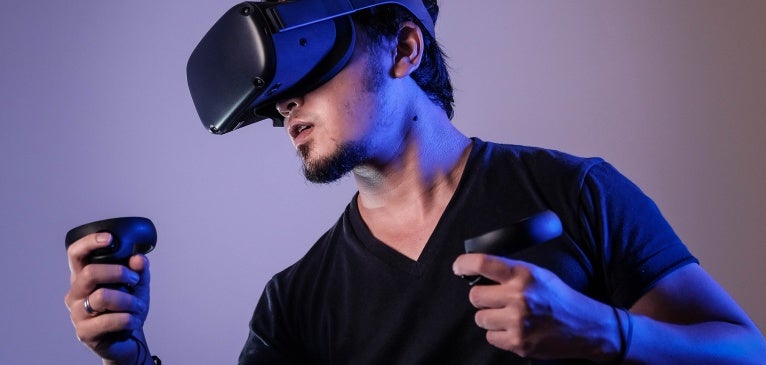TECH Time with Dr. Chansu Yu

Virtual reality isn't just for gamers. Walk into the Dan T. Moore MakerSpace in the lower level of the Washkewicz College of Engineering, and Professor Chansu Yu will quickly spout off the numerous applications of visualization technologies virtual reality (VR), augmented reality (AR) and mixed reality (MR). From local governments, to manufacturing companies, to media and film, these technologies are enabling new experiences, greater efficiencies and deeper understanding. Here, Dr. Yu, a co-director of the CSU TECH Hub, shares highlights of what this technology can do and how students and the community can engage with it at CSU.
Q: What is the difference between VR, AR and MR?
A: VR simulations are fully computer generated, self-contained environments in which users only interact and move in the virtual world. In AR, digital elements are overlayed onto real-world objects, literally augmenting reality with digital elements. In MR, users are able to interact with virtual environments that are projected onto real-world objects.
Q: What visualization tools does CSU offer to students and the community?
A: We recently added 20 Meta Oculus Pros, a new MR system with cutting-edge 3-D technology. We also have five Microsoft HoloLens2 units. These are wearable headsets with holographic projectors just in front of the user's eyes. The HoloLens overlays digital objects on the physical world and allows users to move freely and interact with the digital objects using hand gestures. And then we have the state-of-the-art Viscube M4 CAVE system, a self-contained VR room with immersive virtual reality images projected onto three walls and the floor. Users wear custom goggles that decode 3-D imagery and track the position of the user's head to provide accurate perspective. Multiple users can be in the cube at one time to share the experience. Each spring and fall, we offer a workshop for anyone to learn how to use the devices we have available on campus. This summer, I am working with a student teaching assistant to develop a manual that will cover how to rent and use the equipment as well as how to develop a VR app. (Download the manuals here and here.)
Q: Can you provide some examples of how students and the CSU community are using these technologies?
A: Students are using them in their courses across different disciplines, in computer science, engineering, business, and media and film. More and more students are using the technology in their senior capstone projects. One group re-created the MakerSpace area in VR to let users learn how to use different machines available in the space without the fear of breaking them. Another recent senior capstone project displayed the story behind the Hough riots in a 3-D world. They created a 3-D space that shows the old Hough neighborhood with a narrative of the history, bringing new perspective to education about inequality and systemic racism in Cleveland.
We also have faculty who incorporate the technology in their research. For instance, Dr. Charles McElroy, assistant professor in information systems, and Dr. Ray Henry, associate professor of computer and information science, are using 2-D, AR and VR data visualizations to determine the impact of various data configurations on the level of creativity in perceiving cybersecurity threats.
Q: What about the application of the technology beyond CSU?
A: Local governments and service providers, including the Greater Cleveland RTA and the city of Cleveland, are interested in understanding how VR can help provide deeper levels of perspective and information, essentially creating a digital twin of a street or neighborhood to improve safety and efficiency. Meanwhile, AR and MR can be found on the shop floors of large manufacturing companies, enabling new forms of job training. These technologies are providing workers with digital simulations that help them develop new skills and learn how to use machinery.
Q: What do you see as the future of visualization technology?
A: Including a visualization component in coursework is a key thing, especially for today's students. Including a visualization component in any curriculum on campus will be very impactful for student learning and research productivity. But in terms of mass adoption of the technology, the "disruptive" application of it-it's not a part of our everyday lives. That hasn't been figured out yet.
Click here to learn more about the Dan T. Moore MakerSpace and what it offers. To learn more about Dr. Yu and his research, see his faculty profile page.